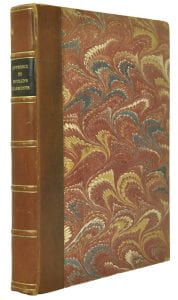3D in the 18th century: John Cowley’s appendix to Euclid’s Elements (1758)
By Erika Delbecque, on 21 June 2019

Ever since the fifteenth century, printers have grappled with the question of how to make geometrical texts easier to understand by illustrating the text with diagrams. However, the flat surface of a page does not easily lend itself to the clear illustration of complex multi-dimensional figures. In a rare 18th-century edition of Euclid’s Elements that UCL Special Collections recently acquired, John Cowley introduced a new technique that enabled readers to create three-dimensional figures while they studied Euclid’s text.
Elements of Geometry by the ancient Greek mathematician Euclid is a mathematical treatise on geometry and the theory of numbers. Dating from around 300 BC, it became the most influential mathematical text ever written. It remained a standard work until the 19th century, and its influence on mathematics, modern science and the reception of classical philosophy cannot be underestimated.
 The Elements has also assumed a central position in printing history from the very beginning. It was one of the earliest mathematical works to be printed (you can find a copy of the first edition of 1482 in our collection), and it is one of the most extensively printed texts ever written, with the number of known editions second only to the Bible. Because the text is typically accompanied by diagrams that illustrate Euclid’s figures, editions of the Elements are also an important source for the study of the history of typography and graphic design.
The Elements has also assumed a central position in printing history from the very beginning. It was one of the earliest mathematical works to be printed (you can find a copy of the first edition of 1482 in our collection), and it is one of the most extensively printed texts ever written, with the number of known editions second only to the Bible. Because the text is typically accompanied by diagrams that illustrate Euclid’s figures, editions of the Elements are also an important source for the study of the history of typography and graphic design.
University College London holds the largest dedicated collection of editions of Euclid in the world. The core of this collection was donated in 1870 by John Thomas Graves (1806-70), Professor of Jurisprudence at UCL, as part of his magnificent mathematical library collection. It has since been added to by subsequent purchases, and now numbers 430 works. The acquisition of the first edition of John Cowley’s An appendix to Euclid’s Elements has filled a conspicuous gap in the collection.
 John Cowley was a leading mathematician of the 18th century. He had a particular interest in how to make Euclidean geometry easier to understand for students. Cowley’s 1758 edition of the sections of the Elements dedicated to solid figures presented an important innovation in the visual representation of Euclid’s figures. It includes 42 diagrams printed on pasteboard, designed to be folded into three-dimensional pop-up figures by the reader. The accompanying text contains step-by-step instructions for folding the figure.
John Cowley was a leading mathematician of the 18th century. He had a particular interest in how to make Euclidean geometry easier to understand for students. Cowley’s 1758 edition of the sections of the Elements dedicated to solid figures presented an important innovation in the visual representation of Euclid’s figures. It includes 42 diagrams printed on pasteboard, designed to be folded into three-dimensional pop-up figures by the reader. The accompanying text contains step-by-step instructions for folding the figure.
 Although the use of pop-up diagrams in editions of the Elements was not new (the first attempt at using these can be found in John Day’s edition of 1570), Cowley’s edition introduced more advanced folding techniques than any previous diagrams, and it was the first attempt at representing polyhedrals in a three-dimensional way. The success of his approach is apparent from the publication of a second edition in 1765, of which there are two copies in the Graves Library collection.
Although the use of pop-up diagrams in editions of the Elements was not new (the first attempt at using these can be found in John Day’s edition of 1570), Cowley’s edition introduced more advanced folding techniques than any previous diagrams, and it was the first attempt at representing polyhedrals in a three-dimensional way. The success of his approach is apparent from the publication of a second edition in 1765, of which there are two copies in the Graves Library collection.
Our copy of Cowley’s 1758 edition will be on display at our South Junction Reading Room between 12 and 2 on Tuesday 27th August as part of our weekly drop-in Rare-Books Club, which is open to all. It is also available for consultation in our reading room, and for use in teaching and academic events. Contact Special Collections for more information.
This acquisition was made possible by a generous grant from the Friends of the National Libraries.
Further reading
Eunsoo, Lee (2018). Let the Diagram Speak: Compass Arcs and Visual Auxiliaries in Printed Diagrams of Euclid’s Elements. Endeavour 42 (2018), 78–98
 Close
Close


